When it comes to makeup, it can be overwhelming to navigate the vast array of products available, especially when they seem to have similar functions. Two such products are highlighters and concealers. But what is the total difference between these two products ?
While both can enhance one’s appearance, they serve different purposes and require different application techniques. Highlighters are used to add dimension and light to the face, while concealer is used to cover up imperfections like blemishes and dark circles. Understanding the difference between the two products can help create a flawless makeup look that meets the specific needs.
So, keep reading to learn everything you need to know about highlighters and concealers.
1. The Basics of Highlighter and Concealer
We know that highlighter and concealer are two essential products in any makeup kit. Highlighters are used to bring a radiant glow to the skin and to emphasize certain areas, such as the cheekbones, bridge of the nose, and inner corners of the eyes. Concealer, on the other hand, is used to cover up dark circles, blemishes, and other imperfections on the skin.
The importance of highlighter and concealer in makeup lies in their ability to enhance the natural beauty of the skin. A well-applied highlighter can create a healthy, youthful glow and add dimension to the face. A good concealer, meanwhile, can help to hide any flaws and create a more even skin tone. These two products work together to create a flawless, airbrushed look.
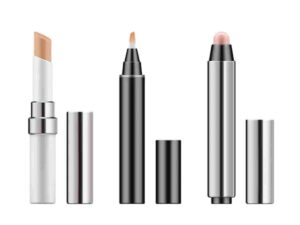
2. Highlighter
Highlighter is a cosmetic product that is used to add a luminous or shimmery effect to certain areas of the face. It is typically applied to the high points of the face, such as the cheekbones, brow bones, and bridge of the nose to create a radiant and glowing appearance.
Types of Highlighter
There are different types of highlighters. Here are some:
Powder Highlighter
This type of highlighter makeup comes in a powder form and is typically applied with a brush. It is great for adding a subtle shimmer to the skin and is suitable for oily skin types.
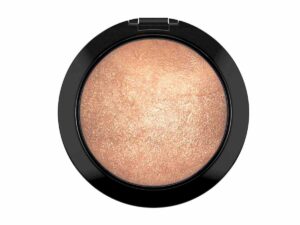
Liquid Highlighter
Liquid highlighters come in a fluid form and are usually applied with a dropper or pump. They are great for creating a natural, dewy look and can be mixed with foundation or applied on top of it.
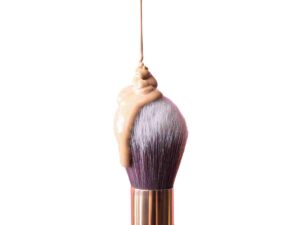
Cream Highlighter
Cream highlighters are similar to liquid highlighters, but have a thicker consistency. They are perfect for adding a more intense glow to the skin. I suggest this type of highlighter for anyone who has dry skin type.
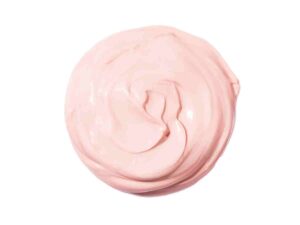
Stick Highlighter
Stick highlighters are a solid, cream-based product that come in a tube or stick form. They are easy to apply and great for highlighting specific areas of the face such as the cheekbones, brow bone, and cupid’s bow.
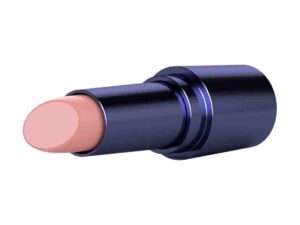
Application Techniques
Here are some popular application techniques for highlighters:
Finger Application
This method involves using the fingers to apply the highlighter. Simply dab a small amount of product on the finger and gently pat it onto the areas that want to highlight. This method is great for cream or liquid highlighters.
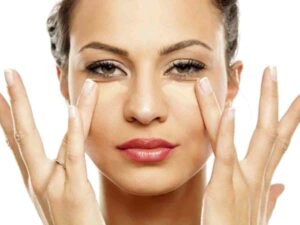
Brush Application
A fan brush is the most popular brush for applying highlighter. Swirl the brush in the highlighter powder and then gently sweep it across the high points of the face. This method works well for powder highlighters.
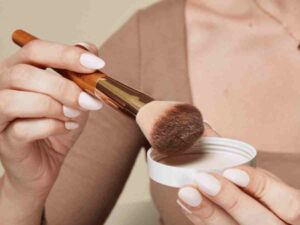
Sponge Application
A damp beauty sponge can be used to apply a highlighter for a seamless, natural finish. Simply dip the sponge in the highlighter and tap it on the high points of the face, then blend out using a bouncing motion.
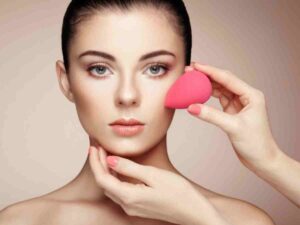
Mixing with Foundation
Another technique is to mix a liquid or cream highlighter with the foundation to create an all-over glow. Simply mix a small amount of highlighter with the foundation before applying it to the face.
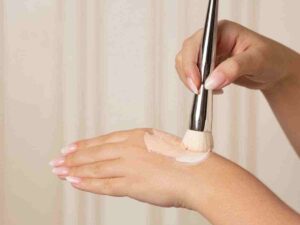
Layering
For a more intense highlight, layering is key. Start with a sheer layer of highlighter and build it up gradually until they achieve the desired level of glow.
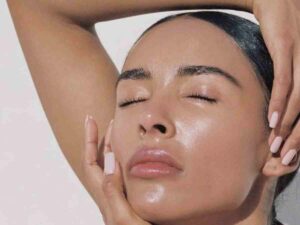
Choosing the Right Shade
Choosing the right shade of highlighter makeup is important to achieve the desired effect. Here are some techniques to keep in mind:
Skin Tone
Consider the skin tone when choosing a highlighter shade. Those with fair skin tones may want to opt for highlighters with a pearl or champagne hue, while those with medium to dark skin tones may want to choose shades with a gold or bronze tone.
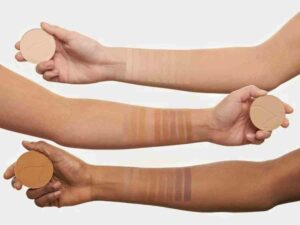
Undertones
Pay attention to the skin’s undertones when selecting a highlighter shade. If anyone has cool undertones, go for highlighters with a silvery or icy tone. If anyone has warm undertones, choose highlighters with a gold or peachy tone.

Occasion
Consider the occasion when selecting a highlighter shade. If anyone is attending a formal event or a nighttime occasion, they may want to go for a more intense highlighter shade. For a daytime or casual look, a more natural and subtle highlighter may be more appropriate.

Formula
Different highlighter formulas may work better with different skin tones and undertones. For example, cream and liquid highlighters may work better for those with dry skin, while powder highlighters may work better for those with oily skin.

Personal Preference
Ultimately, personal preference should guide the highlighter shade choice. Choose a shade that you feel comfortable with and that complements the overall makeup look.

Benefits of Highlighter
Highlighter makeup has several benefits that can help enhance your overall makeup look. Here are some benefits of a highlighter:
Enhancing Facial Features
Highlighter makeup can be used to enhance the natural features and draw attention to the best features, such as the cheekbones, brow bones, and cupid’s bow.

Brightening the Complexion
Highlighter makeup can be used to brighten the complexion, especially in areas that are prone to shadow or dullness, giving the skin a luminous and healthy glow.

Creating Dimension
Highlighter makeup can be used to create the illusion of depth and dimension, adding a three-dimensional look to the face, especially when paired with contouring products.

Complements Other Makeup
Highlighter makeup can be used to complement other makeup products, such as bronzer or blush, by adding balance and harmony to the overall makeup look.

3. Concealer
Concealer is a cosmetic product that is used to hide or minimize the appearance of blemishes, dark circles, and other imperfections on the skin. It is typically applied after foundation and before any other makeup product to create a smooth and even complexion.
Types of Concealer
There are different types of concealer. Here are some:
Liquid Concealer
This type of concealer has a liquid consistency and is great for creating a natural finish. It is easy to blend and can be built up for higher coverage.

Cream Concealer
Cream concealer has a thicker consistency than liquid concealer and is ideal for covering up blemishes and dark circles. It provides fuller coverage and works well for dry skin types.
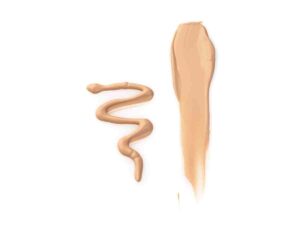
Pen Concealer
Pen concealer has a thin and precise applicator, which is perfect for covering small areas such as blemishes or spots. It provides light to medium coverage and is easy to apply on-the-go.

Color-Correcting Concealer
Color-correcting concealers come in a range of shades that target specific color issues. For example, green concealers help to neutralize redness, while peach or orange concealers can help to cover dark circles.

Application Techniques
Here are some popular application techniques for concealer:
Spot Application
This method involves applying concealer directly to problem areas, such as blemishes or dark circles, using a small brush or finger. Simply dab a small amount of concealer onto the area and blend it out with a brush or finger.
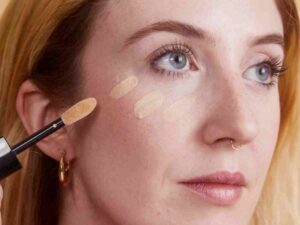
Triangle Application
This method is great for covering dark circles under the eyes. Apply concealer in a triangular shape under the eyes, with the point of the triangle facing downward. I suggest blending the edges out for a seamless finish.

Stippling
Stippling involves dabbing concealer onto the skin in a light tapping motion using a stippling brush. This method helps to build up coverage gradually for a more natural look.

Layering
For areas that need more coverage, apply concealer in thin layers, building up the coverage as needed. Let each layer dry before applying the next to avoid creasing or caking.
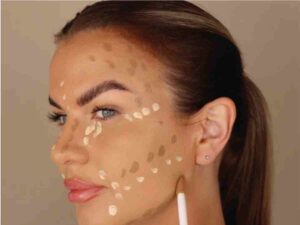
Mixing
You can also mix the concealer with a moisturizer or primer to create a more sheer and natural finish. Simply mix a small amount of concealer with the favorite skincare product and apply as usual.

Choosing the Right Shade
Choosing the right shade of concealer is important to achieve a natural and seamless look. Here are some techniques to help you choose the right shade for the skin tone:
Determine the Skin Tone
Identify the skin tone first, whether it’s warm, cool or neutral. This will help you choose the right shade that matches the skin tone.
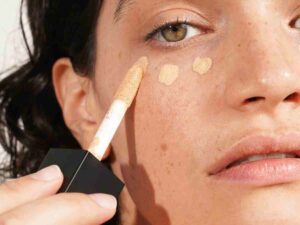
Decide the Purpose
Determine the purpose of the concealer. If anyone is using it to cover dark circles, choose a shade that is one or two shades lighter than the skin tone. If anyone is using it to cover blemishes or discoloration, choose a shade that matches the skin tone.
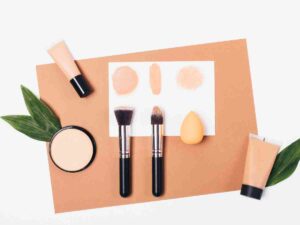
Test in Natural Light
Always test the concealer in natural light to see how it looks on the skin. Artificial lighting can sometimes alter the color of the product.
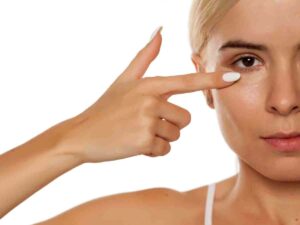
Don’t Go Too Light or Too Dark
Avoid choosing a concealer that is too light or too dark for the skin tone as it can create an unflattering contrast.
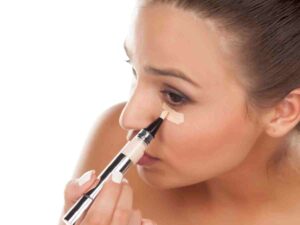
Consider Undertones
Look for a concealer shade that complements the skin’s undertones. If anyone has cool undertones, choose a concealer with a pink or blue undertone. If anyone has warm undertones, opt for a concealer with a yellow or golden undertone.
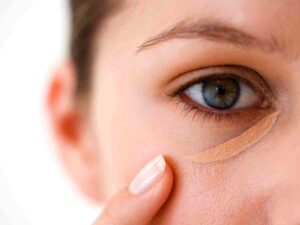
Benefits of Concealer
Concealer is a versatile makeup product that provides several benefits to the skin. Here are some benefits of concealer:
Hides Blemishes
Concealer is perfect for hiding blemishes, such as acne, scars, and dark spots. It provides fuller coverage than foundation and can be applied directly to the affected area.
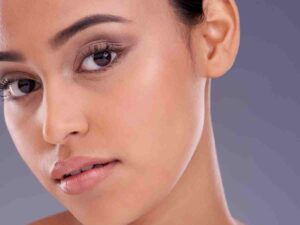
Reduces Dark Circles
Concealer is often used to cover dark circles under the eyes, providing a more awake and refreshed appearance.
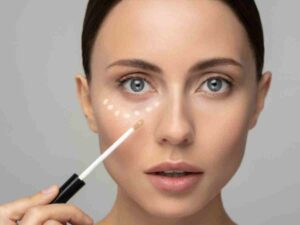
Brightens the Complexion
Concealer can help to brighten up a dull or tired complexion, giving the skin a more radiant and youthful appearance.

Contours the Face
Concealer can be used to contour the face by highlighting certain areas and creating a more defined and sculpted look.
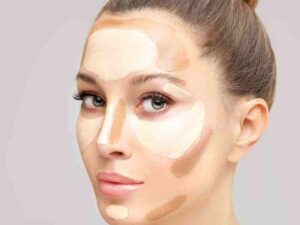
Versatile
Concealer can be used for various purposes, including color correction, highlighting, and contouring. It can also be used alone or in combination with other makeup products.
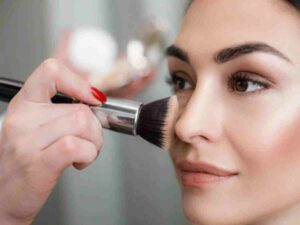
4. Highlighter Vs. Concealer
According to a report by Grand View Research, the global market size for the cosmetics industry is expected to reach $758.4 billion by 2025, driven by the increasing demand for makeup products, including highlighters and concealer. Highlighters and concealer are both makeup products used for different purposes, and they differ in several ways.
Coverage
The primary purpose of concealer is to provide coverage by hiding blemishes, dark circles, and other imperfections. Highlighter is used to add a luminous effect to certain areas of the face, without providing much coverage.
Texture
Highlighters and concealers come in different textures. Highlighters are usually available in powder, cream or liquid forms, while concealers are available in liquid, cream or stick forms.
Formula
Concealers have a higher pigment concentration to provide coverage, while highlighters have a lower pigment concentration and contain light-reflecting particles to add radiance to the skin. I recommend choosing a formula that suits the skin type and needs.
Purpose
Concealer is used to cover up imperfections and create an even skin tone. Highlighter is used to add dimension and luminosity to the face.
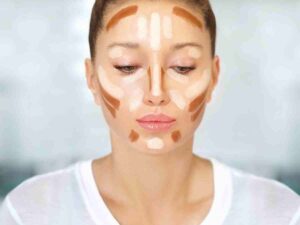
Placement
Concealer is typically placed on areas that need coverage, such as under the eyes, blemishes, and dark spots. Highlighters are applied to areas that need to be emphasized or brightened, such as the cheekbones, brow bones, and bridge of the nose.
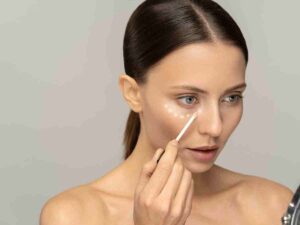
Difference in Application
Concealer is typically applied with a brush or sponge in a patting or stippling motion, while highlighter is typically applied with a brush or fingers in a sweeping or dabbing motion.
Here’s a table comparing the differences in application of concealer and highlighter:
|
Concealer |
Highlighter |
| Brush |
A dense, flat brush can provide a full coverage finish and precise application, while a fluffy brush can create a lighter coverage and blend the product seamlessly into the skin. |
A small, fluffy brush is perfect for a targeted application and blending the product into the skin, while a larger brush can provide a more diffused effect. |
| Fingers |
Applying with fingertips allows for more control over the product and can blend the product into the skin for a natural finish. |
Patting the product onto targeted areas with fingertips and blending outwards can create a natural, subtle glow. |
| Sponge |
Using a damp sponge can provide an airbrushed finish and seamlessly blend the product into the skin. |
Dabbing onto targeted areas using a damp sponge and blending outwards can create a diffused effect for a natural-looking glow. |
| Dual-Ended Brush/Sponge Applicator |
The brush end can provide precise application, while the sponge end can blend the product seamlessly into the skin for a flawless finish. |
The brush end can target specific areas for application, while the sponge end can blend the product outwards for a natural-looking glow. |
Note: Application methods and tools may vary depending on personal preference, skin type, and the specific product being used.
Overall, highlighters and concealer are both essential makeup products that serve different purposes and can be used together to create a flawless and radiant complexion.
5. 3 Tips on How to Use The Highlighter and Concealer Together
Highlighters and concealer are two makeup products that can be used together to create a flawless and glowing complexion. Here are some tips on how to use a highlighter and concealer together:
#1 The Order of Application
When using highlighter and concealer together, I suggest applying them in the right order. Start by applying the concealer to cover up any blemishes or dark circles. Then, apply your foundation and finish with the highlighter. Applying the highlighter last will help to ensure that it stands out and doesn’t get covered up by other products.
#2 Blending Techniques
Blending is key when using highlighter and concealer together. Use a brush or sponge to blend the concealer seamlessly into the foundation, making sure that there are no harsh lines or edges. When applying the highlighter, use a light hand and blend it into the foundation and skin for a natural and subtle glow.
#3 Tips and Tricks
Here are some tips and tricks to make the most out of using highlighters and concealer together:
- Use a color-correcting concealer to target specific color issues, such as redness or dark circles, before applying the regular concealer.
- Mix a small amount of highlighter with the foundation for an all-over glow.
- Apply the highlighter before setting the makeup with powder to ensure that it pops and stands out.
- Apply a thin layer of highlighter on the collarbones, shoulders, and décolletage for a full-body glow.
- Use a cream highlighter for a more natural and subtle look, and a powder highlighter for a more intense and shimmery effect.
If you’re looking for a reputable cosmetic manufacturer, Nako Cosmetic is an ideal choice. We offer a wide range of high-quality makeup products, including concealer and highlighters, that are designed to enhance and complement your natural beauty. Our products are made using safe and natural ingredients that are gentle on the skin and free from harsh chemicals. Contact us today to learn more.
Dive Deeper Into Our Resources
Looking for more diverse product options? Browse through our handpicked selections:
Still haven’t found what you’re looking for? Don’t hesitate to contact us. We’re available around the clock to assist you.
6. Conclusion
In conclusion, highlighters and concealer are both essential makeup products that serve different purposes. They differ in terms of coverage, texture, formula, purpose, placement and application. By understanding the differences between these two products, you can choose the right product for your needs.
I hope this information has been helpful to you in understanding the difference between highlighter and concealer. If you still have any questions or need further guidance, don’t hesitate to contact us at Nako Cosmetic. Our team of experts is always here to help you.







































